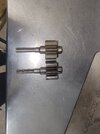A non-pilot friend bought a 61 172 sight unseen out of Texas. He had a pre-buy done which turned into an annual. They even did a borescope on the engine. It was a good price and there was room for some investment. The ferry flight went through Hugoton, KS for cheap gas. After fueling, the ferry pilot got no oil pressure indication on startup, and shut it down. A mechanic from Liberal (I think) came out and found the oil pump had failed but likely no damage to the engine since it was shut down immediately with no oil pressure indication after starting. Ferry pilot goes home. Mechanic orders new oil pump and also says accessory case needs to be replaced, so finds another one somewhere. Engine goes back together and still no oil pressure. What to do now?
One option presented to the owner is a major overhaul. I suggested letting the mechanic dig deeper to fix the problem. I'm thinking there must be some blockage or clogging in the oil system. Now wondering if the oil pump was even bad in the first place?
I told the owner he should consider just pulling the wings off the thing and move it home to WA so he can be directly involved with further decisions and use a trustworthily local mechanic. The owner is part of a large family business that is a local fuel distributer and they have several big trucks. I'm trying to find out if they have a flatbed trailer in the mix.
Any mechanic's on here have any ideas on what the poor owner should do now short of doing a major on an O-300? Engine has 400 hours SMOH but the overhaul was likely done many years ago. I've owned 10 small GA planes and have avoided this nightmare aircraft ownership scenario. I was going to teach the owner how to fly this summer. For me, moral of the story is a pre-purchase or annual is no guarantee that something really bad might happen after you buy a plane. Maybe I've been lucky all these years.

